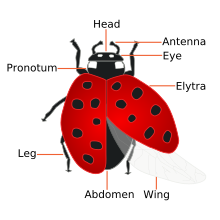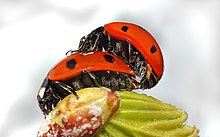Coccinellidae
| Coccinellidae | |
|---|---|

| |
| Coccinella septempunctata | |
| Scientific classification | |
| Kingdom: | |
| Phylum: | |
| Class: | |
| Order: | |
| Superfamily: | |
| Family: | Coccinellidae Latreille, 1807
|
| Subfamilies | |
|
Chilocorinae | |




Coccinellidae is a family of beetles, known variously as ladybirds (British English, Australian English, South African English), ladybugs (North American English) or lady beetles (preferred by some scientists). The family name comes from its type genus, Coccinella. Coccinellids are found worldwide, with over 5,000 species described[1], more than 450 native to North America alone. Coccinellids are small insects, ranging from 1 mm to 10 mm (0.04 to 0.4 inches), and are commonly yellow, orange, or scarlet with small black spots on their wing covers, with black legs, head and antennae. A very large number of species are mostly or entirely black, gray, or brown, however, and may be difficult for non-entomologists to recognize as coccinellids (and, conversely, there are many small beetles that are easily mistaken as such, like tortoise beetles).
They are generally considered useful insects as many species feed on aphids or scale insects, which are pests in gardens, agricultural fields, orchards, and similar places. Some people consider seeing them or having them land on one's body to be a sign of good luck to come, and that killing them presages bad luck. A few species are pests in North America and Europe.
Biology
Coccinellids are typically predators on Hemiptera such as aphids and scale insects, though members of the subfamily Epilachninae are herbivores, and can be very destructive agricultural pests (e.g., the Mexican bean beetle). They are also known to eat certain plants and crops when no other food is present, making them a possible pest to farmers and gardeners. While they are often used as biological control agents, introduced species of ladybirds (such as Harmonia axyridis or Coccinella septempunctata in North America) can outcompete and displace native coccinellids, and become pests in their own right.
Coccinellids are often brightly coloured to ward away potential predators. This defense works because most predators associate bright colours (especially orange and black or yellow and black) with poison and other unpleasant properties. This phenomenon is called aposematism. In fact, most coccinellids are indeed poisonous to smaller predators, such as lizards and small birds; however, a human would have to eat several hundred coccinellids before feeling any effects.[citation needed] Adult coccinellids are able to reflex-bleed hemolymph from their leg joints, releasing their oily yellow toxin with a strong repellent smell. This becomes quite obvious when one handles a coccinellid roughly.
Most Coccinellids mate in Spring or Summer and the female lays a cluster of eggs (numbering from a few to a few hundred, depending on species) as near as possible to an aphid colony. In most species these eggs hatch into a larval state within a week. This state lasts 10–15 days, and they then go into a pupal stage before becoming an adult coccinellid. The entire life cycle of the Coccinellid is only 4–7 weeks. Most ladybird species are univoltine, producing only one generation a year, although some are bivoltine.
Coccinellids lay extra infertile eggs with the fertile eggs. These appear to provide a backup food source for the larvae when they hatch. The ratio of infertile to fertile eggs increases with scarcity of food at the time of egg laying.[2]
Some species are migratory and form large aggregations during the migratory period. They also form large aggregations when they go into hibernation in Winter.[3]
Habitats
Most coccinellids are beneficial to gardeners in general. In the Spring, one could usually find a ladybird in a vegetable garden feeding on aphids. As in many insects, ladybirds in temperate regions enter diapause during the Winter. Some species (e.g., Hippodamia convergens) gather into groups and move to higher land, such as a mountain, to enter diapause. Ladybirds are usually found where aphids or scale insects are, and they lay their eggs near their prey, to increase the likelihood the larvae will find the prey easily. Since aphids and scale insects occur nearly everywhere in the world, ladybirds are also cosmopolitan.
Coccinellids as household pests
Although native species of coccinellids are typically considered benign, in North America the Asian lady beetle (Harmonia axyridis), introduced in the twentieth century to control aphids on agricultural crops, has become a serious household pest in some regions owing to its habit of overwintering in structures. It is similarly acquiring a pest reputation in Europe, where it is called the "Harlequin Ladybird" (see main article "Asian lady beetle" for discussion).
Coccinellids in popular culture
Coccinellids are and have for very many years been favourite insects of children. The insects had many regional names (now mostly disused) such as the lady-cow, may-bug, golden-knop, golden-bugs (Suffolk); and variations on Bishop-Barnaby (Norfolk dialect) - (Barney, Burney) Barnabee, Burnabee, and the Bishop-that-burneth.
The ladybird is immortalised in the still-popular children's nursery rhyme Ladybird, Ladybird:
Ladybird, ladybird, fly away home
Your house is on fire and your children are gone
All except one, and that's Little Anne
For she has crept under the warming pan.
Many variants exist, including one that seems ancient (recounted in an 1851 publication):
Dowdy-cow, dowdy-cow, ride away heame,
Thy house is burnt, and thy bairns are tean,
And if thou means to save thy bairns
Take thy wings and flee away!

The name that the insect bears in the various languages of Europe is clearly mythic. In this, as in other cases, the Virgin Mary has supplanted Freyja, the fertility goddess of Norse mythology; so that Freyjuhaena and Frouehenge have been changed into Marienvoglein, which corresponds with Our Lady's Bird. The esteem with which these insects are regarded clearly has roots in ancient beliefs.[4] In Irish, the insect is called bóín Dé — or "God's little cow"; similarly, in Croatian it is called Božja ovčica ("God's little sheep"). In France it is known as bête à bon Dieu, "the Good Lord's animal"[5], and in Russia, Божья коровка, or Корова бога ("God's cow")[5], while in Yiddish, it is called "Moshe Rabbenu's little cow" or "Moshe Rabbenu's little horse", apparently an adaptation of the Russian name, or sometimes "Little Messiah".[5]
In parts of Northern Europe, tradition says that one's wish granted if a ladybird lands on oneself. In Italy, it is said by some that if a ladybird flies into one's bedroom, it is considered good luck. In central Europe, a ladybird crawling across a girl's hand is thought to mean she will get married within the year. In some cultures they are referred to as lucky bugs (Turkish: uğur böceği).
In Russia, a popular children's rhyme exists with a call to fly to the sky and bring back bread; similarly, in Denmark a ladybird, called a mariehøne ("Mary's hen"), is asked by children to fly to 'our lord in heaven and ask for fairer weather in the morning'.
In Greece, ladybugs are called πασχαλίτσα (paschalitsa), because they are found abundantly in Eastertime along with paschalia, the Common Lilac plant, which flowers at the same time.
- The ladybird is the symbol of the Dutch Foundation Against Senseless Violence, as can be seen in the logo.
- Other companies using ladybirds as their corporate logo include: Ladybird Books (owned by Pearson PLC); the Ladybird range of children's clothing sold by Woolworth's in the UK; the Polish supermarket chain Biedronka and the software development firm Axosoft.
- The British band XTC included a song called "Ladybird," an affectionate ode to the insect, on their 1983 album Mummer.
- The ladybird is a symbol of the Finnish Swedish People's Party.
- The British band The Fall included a song called "Ladybird (Green Grass)," on their 1993 album The Infotainment Scan.
- In the popular Pixar animated film, A Bug's Life, Francis the Ladybug is an aggressive male flea circus performer who is deeply annoyed when his gender is confused.
- The Pokémon Ledyba and Ledian are both based on the ladybug. The Digimon Tentomon also bears resemblance to a ladybug.
- The Bad-Tempered Ladybird is a book by Eric Carle.
- Many states in the U.S. have chosen a ladybird species as their state insect; Delaware, Massachusetts, New Hampshire, New York, Ohio, Pennsylvania, and Tennessee.
Additional photographs
-
Pupal stage of a coccinellid
-
Hippodamia overwintering en masse (Colorado Springs, Colorado)
-
Anatis on a pine cone
-
Coccinella species from the U.S.
-
P-14 coccinellid consuming an aphid
-
Larvae just hatched from their eggs
-
Harmonia axyridis deploying wings
-
Hippodamia hiding within a flower bud
-
Lady beetle larva eating an aphid
References
- ^ Judy Allen & Tudor Humphries (2000). Are You A Ladybug?, Kingfisher, p. 30
- ^ J. Perry & B. Roitberg (2005). "Ladybird mothers mitigate offspring starvation risk by laying trophic eggs". Behavioral Ecology and Sociobiology. 58: 578–586.
{{cite journal}}: Unknown parameter|quotes=ignored (help) - ^ A. Honek, Z. Martinkova & S. Pekar (2007). "Aggregation characteristics of three species of Coccinellidae (Coleoptera) at hibernation sites" (PDF). European Journal of Entomology. 104 (1): 51–56.
{{cite journal}}: Unknown parameter|quotes=ignored (help) - ^ "Bishop Barnaby". Notes and Queries. 9. 1849-12-29.
{{cite journal}}: Check date values in:|date=(help) - ^ a b c Born to Kvetch, Michael Wex, St. Martin's Press, New York, 2005, ISBN 0-312-30741-1
External links
- BBC Science & Nature: 7-spotted ladybird
- Ladybugs of North America — diagnostic photographs
- Multicolored Asian ladybug Harmonia axyridis male and female specimens photos
- Ladybirds page on The Earth Life Web
- Ladybeetles on eNature
- Harlequin Ladybird survey in the British Isles
- Unofficial Homepage to the Asian ladybird beetle
- General Information on Ladybugs (Asian LadyBeetle)
- Biological control: Predators: Lady beetles Cornell University's Guide to natural enemies in North America
- Taxonomy of coccinellids











